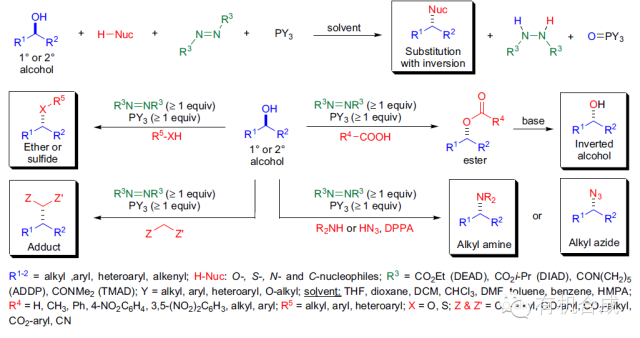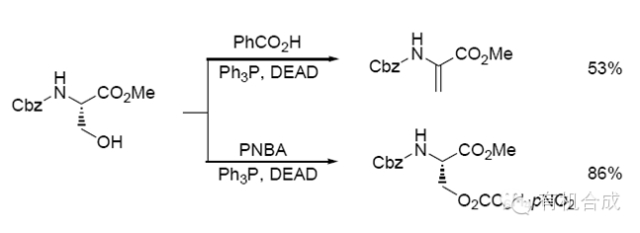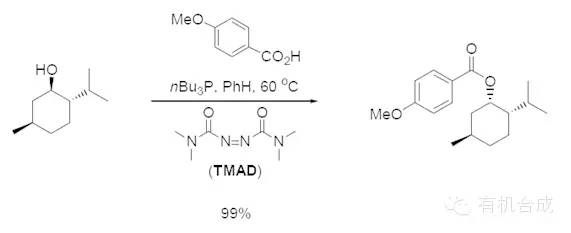Mitsunobu reaction (Mitsunobu reaction) is a bimolecular nucleophilic substitution reaction (SN2 reaction). In 1967, Mitsunobu reported a new method for the condensation of acids and alcohols into esters under the action of triphenylphosphine (PPh3) and diethyl azodicarboxylate (DEAD). When the substrate is a secondary alcohol, the configuration of the carbon atom connected to the hydroxyl group will flip. After years of research and development, a large class of synthetic methods has been formed, which we call the Mitsunobu reaction. This type of reaction is widely used in organic synthesis, especially in the synthesis of natural products. The reaction can be expressed as:

Reaction mechanism:
The Mitsunobu reaction mechanism is quite complex, and there is still much debate about the intermediate entities and their roles.

First, triphenylphosphine attacks DEAD to form an intermediate, seizes the carboxylic acid proton to form a positive ion, the nucleophile attacks the phosphine center of the ion to form a phosphine oxide ion, and DEAD falls off to form a by-product of hydrazine. Although many phosphine intermediates are involved in the reaction, step 4 is the only way to form the product and the triphenylphosphine oxide by-product is finally obtained.
Reaction characteristics:
1. Primary alcohols and secondary alcohols can undergo Mitsunobu reaction. Secondary alcohols flip chirality and tertiary alcohols do not react. 2. The pKa value of the proton of the nucleophile must be smaller than the pKa value of the betaine intermediate (~13 ), otherwise the proton of the nucleophile cannot be captured by the intermediate; 3. The main products of oxygen nucleophiles are esters and ethers, sulfur nucleophiles mainly produce thioethers, and common nitrogen nucleophiles include imides, hydroxylamines, and hybrids. Cyclic nitrogen and hydrazoic acid; 4. Carbon-carbon bonds can also be generated. Nucleophiles are mainly active methylene compounds, such as β-diketones, β-keto acid esters, etc., but the activity of β-diesters cannot be reached. ; 5. Intramolecular reactions can be carried out, and three-, four-, five-, six- and seven-membered cyclic ethers and cyclic amines can be prepared by this reaction; 6. Use acid halide, zinc halide or lithium halide as the halide ion source. Alcohols can be converted into corresponding halides; 7. Low polarity solvents are beneficial to the reaction. Tetrahydrofuran, diethyl ether, dichloromethane and toluene are usually used as solvents. Sometimes ethyl acetate, acetonitrile and DMF are also used as solvents; 8. , PPh3 and P(n-Bu)3 are the most commonly used phosphine ligands, and the commonly used azodicarboxylate esters are DEAD and DIAD. These two reagents are interchangeable in the reaction; 9. The reaction temperature is usually between 0°C and Between 25°C and 25°C, the reaction temperature should also be increased if the substrate has greater steric hindrance; 10. The order of feeding is crucial. First, the nucleophile, substrate, and triphenylphosphine should be dissolved in an appropriate solvent, such as tetrahydrofuran. (or diethyl ether, etc.), cool to zero, then slowly add DEAD dropwise, and finally stir at room temperature. If the reaction is not completed, the temperature can be raised to room temperature or heating can be continued. Another feeding method is to stir triphenylphosphine and DEAD in the solvent first, and then add the substrate and nucleophile to the solvent in sequence.
The turning of alcohol
Using p-nitrobenzoic acid (PNBA) as a nucleophile is more effective in flipping alcohols with greater steric hindrance. p-nitrobenzoic acid (PNBA) can also effectively inhibit side reactions: the elimination of alcohols. . Therefore, p-nitrobenzoic acid (PNBA) is usually used as the nucleophile in the Mitsunobu reaction.

Tsunoda et al. found that for alcohols with greater steric hindrance, the system of TMAD (N, N, N’, N’-tetramethyl-azodicarboxamide) and tributylphosphine works better.


 微信扫一扫打赏
微信扫一扫打赏

